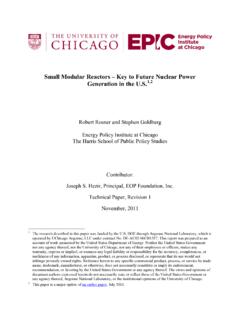Transcription of Perform Common Process Loop Control Algorithms
1 Perform Common Process Loop Control Algorithms Using the PIDE Instruction Introduction This white paper discusses how to use the features inherent in the Enhanced PIDE instruction in the RSLogix 5000 Function Block Diagram (FBD) editor to Perform Common Process loop Control Algorithms such as: adaptive gains cascade Control ratio Control multiloop selection split-range time-proportioning Although this paper focuses on the PIDE instruction, be aware that the FBD editor supports many other Process Control instructions. Other instructions provide capabilities such as flow totalization, ramp/soak temperature profiles, motor operated valve Control , and two- or three-state device Control for devices such as pumps and solenoid valves.
2 These instructions provide you with the building blocks you need to Perform typical Process Control applications. 2 | Perform Common Process Loop Control Algorithms Velocity vs. Positional Control The PIDE instruction uses a velocity form algorithm of the PID equation. Essentially, this means that the loop works on change in error to change the output. Traditional PID Algorithms used in PLCs have used positional form Algorithms . A positional form algorithm works on error directly. Although this is acceptable for simple applications, the velocity form algorithm is much easier to apply for more advanced applications such as adaptive gains or multiloop selection. For this reason, most Distributed Control Systems (DCS) have traditionally used a velocity form algorithm.
3 Likewise, the Logix controller family also takes advantage of the more advanced properties of a velocity form algorithm. Understand that both a positional form and a velocity form PID algorithm Perform identically in response to a change in error. In fact, you can easily derive one form of the equation from the other. The equations for the two types of Algorithms are shown below: Positional Form PID Algorithm Velocity Form PID Algorithm where: CV = Controlled Variable E = Error t = Update time Kp = Proportional gain KI = Integral gain KD = Derivative gain The two main differences between the forms of the PID algorithm are that: the proportional term works on change in error ( E) in the velocity form and on error (E) in the positional form the accumulation of the integral term is contained in the previous output (CVn-1) in the velocity form and in the summation of the integral term in the positional form.
4 The following sections explain why this is important. The PIDE instruction also supports two different forms of the velocity form algorithm independent and dependent gains. These are described below: tEEEKtEKEKCVCVnnnDIPnn 2112 tEKtEKEKCVDIP3 | Perform Common Process Loop Control Algorithms Independent Gains Form In this form of the algorithm, each term of the algorithm, proportional, integral, and derivative, has a separate gain. Changing one gain affects only that term and not any of the others. where: CV = Control variable E = Error in percent of span t = Update time in seconds used by the loop KP = Proportional gain KI = Integral gain in min-1. Note that a larger value of KI causes a faster integral response.
5 KD = Derivative gain in minutes Dependent Gains Form In this form of the algorithm, the Proportional gain is effectively changed into a Controller gain. By changing the Controller gain, you change the action of all three terms, proportional, integral, and derivative, at the same time. where: CV = Control variable E = Error in percent of span t = Update time in seconds used by the loop KC = Controller gain TI = Integral time constant in minutes per repeat. In other words, it will take TI minutes for the integral term to repeat the action of the proportional term in response to a step change in error. Note that a larger value of TI causes a slower integral response. TD = Derivative time constant in minutes When you use the PIDE instruction with the parameter DependIndepend cleared, the parameters PGain, IGain, and DGain are used to represent KP, KI, and KD.
6 When DependIndepend is set, you use the parameters PGain, IGain, and DGain to represent KC, TI, and TD. tEEEKtEKEKCVCVnnnDIPnn 21126060 tEEETtETEKCVCVnnnDICnn2112606014 | Perform Common Process Loop Control Algorithms The PIDE equations above are representative of the Algorithms used by the PIDE instruction. You can substitute the change in error values by the change in PV (in percent of span) for the proportional and derivative terms by manipulating the parameters PVEP roportional and PVED erivative. By default, the PIDE instruction actually uses the change in error for the proportional term and the change in PV for the derivative term. This eliminates large derivative spikes on changes in setpoint. You can convert the gains used between the independent and dependent gains PIDE algorithm forms by using the following equations: CPKK DCDTKK Either algorithm type independent or dependent can give you identical Control with the appropriate gains.
7 It really just depends on with which style of PID algorithm you have the most familiarity. Some people prefer the independent gains style since they can manipulate individual gains without affecting the other terms. Others prefer the dependent gains style since they can, at least to a certain extent, change only the controller gain and cause an overall change in the aggressiveness of the PID loop without changing each gain separately. Adaptive Gains One of the big advantages of a velocity form algorithm is the implementation of adaptive gains. Implementing adaptive gains simply means that you change the proportional, integral, and derivative gain values in a running loop. This is often desirable since a Process may have very different operating characteristics depending on the actual operating environment.
8 For example, the barrel temperature Control of an extrusion machine often involves heating the barrel with resistive heaters and cooling the barrel by running coolant through lines around the barrel. The heating and cooling of the barrel are two different physical processes and often require different gain values in order to obtain the best Control . Typically this is accomplished by defining 50% loop output as providing no heating or cooling. An output greater than 50% applies increasing heating, and an output less than 50 % applies increasing cooling. With a positional form algorithm, swapping in new gains as the loop changes from heating to cooling is very difficult. Since the proportional term on a positional form algorithm works directly on error, any error at the point at which the gains change causes a bump in output proportional to the difference between the heating and cooling proportional gains.
9 For example, assume that the heating proportional gain is 3 and the cooling proportional gain is 1. Now, if the loop output moves from cooling to heating ( , crosses 50%), and, when it does so, the error is at 5%, the loop experiences a 10% bump in output when you switch it to the heating gains. This is because the positional form PID algorithm works on error directly. It is very difficult to get good Control when the output is bumped just ICITKK 5 | Perform Common Process Loop Control Algorithms because of new gains. To handle this correctly, you really need to put the loop in manual, put in the new gains, execute the loop in manual once to allow it to back-calculate for a bumpless transfer, and then finally put the loop back into automatic to start using the new gains.
10 This is difficult and time-consuming to program correctly. Now do the same thing with a velocity form algorithm. Changing the proportional gain from 1 to 3 with a 5% error causes no change in the output since the error was 5% just before the new gain was used and remained 5% just after the new gain was used. Since the error didn t change, no proportional term change is made to the output. You now see why implementing adaptive gains Control schemes is much easier with the velocity form PIDE algorithm used in Logix. You can simply swap in new gain values on-the-fly without worrying about bumping your Process . Multiloop Selection There are times when two or more Process variables are controlled by the same Control variable.













